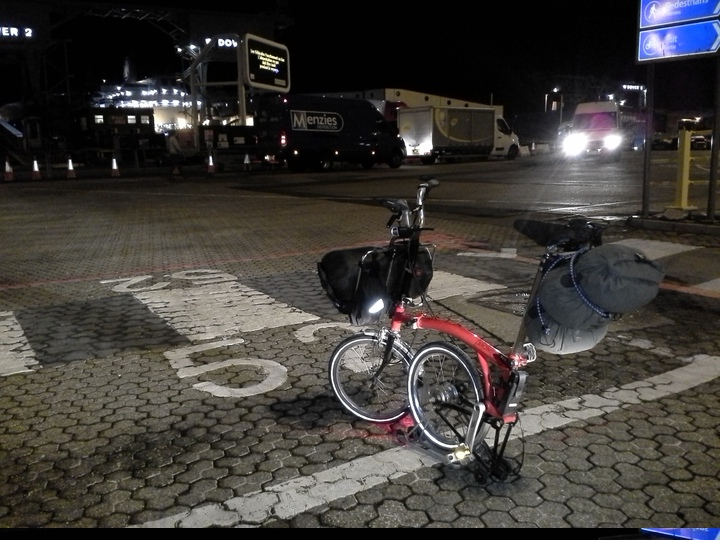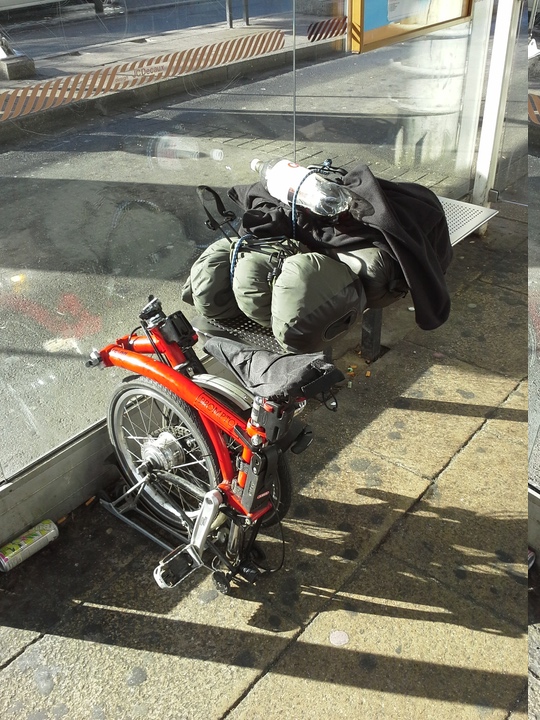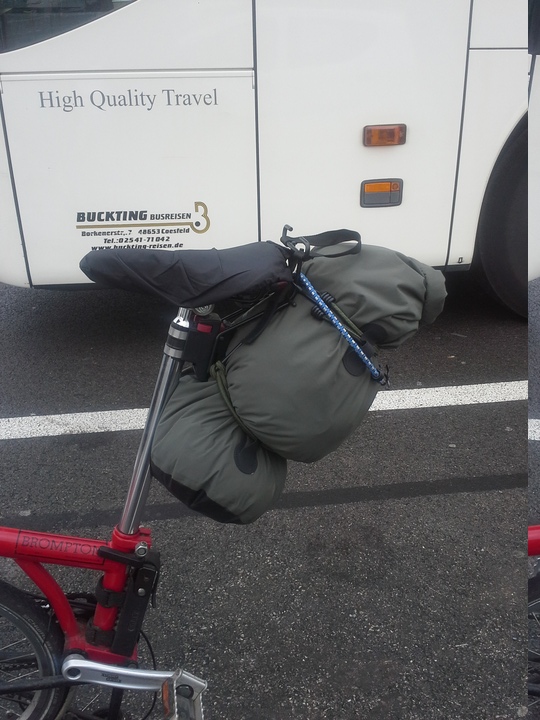A few years back I got a Brompton folding bike for use when commuting to work in the Netherlands. It's a lovely bike, folds up well, and rides beautifully. It's become my main bike of choice, for pretty much every bike ride in recent years.
But as it came out the factory, it's load carrying capability was less than perfect, and the gear range wasn't quite upto the hills we have in Kent (I did buy it in Amsterdam...).
I've spent the last year or so upgrading parts of the bike to make it the ideal Bushcraft touring bike. This last weekend saw it's first outing in it's new configuration, a nice easy Jaunt from Kent, to the Ardenne... in Luxembourg...
One of the joys of the Brompton is that you can fold it up easily and take it on public transport without any difficulty[1], so my trip to Luxembourg involved a Ferry from Dover to Dunkerque, a 16km bike ride to Dunkirk station, a bus ride to De Panne, where I got the train to Brussels, to meet a friend to go onwards to Luxembourg by car. The Brompton operated flawlessly through out, as well as carrying my full camping kit for the trip.
One of the tricky requirements of any modification to the Brompton is that of maintaining the fold. You could easily put bar ends on that are too big, and they would interfere with the fold. Or if you attach a bag to the rear rack, it makes folding the bike up a right sod.
The modifications I made were:
So what does the touring configured Brompton look like?

Pictured here waiting to board the ferry at Dover. Flipping the backwheel under doubles as a convenient stand.

Broken down into the component parts ready to board the bus in Dunkirk.

Close up of the rear rack and dry bag configuration.
I used a 35L dry bag on the rear rack, and a 20L dry bag on the front. In summer, using the considerably more compact summer sleeping bag, I could fit everything I need into the 35L bag on the rear, so I could then do away with the front rack entirely. For this trip the 20L dry bag on the front contained just my winter sleeping bag, and nothing more. Currently the bags are attached with Bungees, I am not certain this is the best solution, so may experiment some in the coming weeks. I would like to find an easy way of adding a couple of pockets or something to the dry bag, I don't have anywhere to put say a wet tarp, or a fuel bottle so my sleeping bag doesn't smell of meths, that sort of thing, but for now this is working well.
One thing people often comment about the Brompton is that it's a toy bike with tiny wheels, only suited to the commute. This isn't true, I've climbed to the highest point of country's on this bike, ridden through 1ft deep flood water, and offroaded through woodland bridleways awash with mud. The bike isn't the limit, it's the bit between the saddle and the handlebars that lets the side down...
All together, this is becoming a really capable touring bike, and I intend to use her for Bushcraft trips in the near future.
Julia
[1]some backward train operators do insist on you having a cover fitted when doing so...
But as it came out the factory, it's load carrying capability was less than perfect, and the gear range wasn't quite upto the hills we have in Kent (I did buy it in Amsterdam...).
I've spent the last year or so upgrading parts of the bike to make it the ideal Bushcraft touring bike. This last weekend saw it's first outing in it's new configuration, a nice easy Jaunt from Kent, to the Ardenne... in Luxembourg...
One of the joys of the Brompton is that you can fold it up easily and take it on public transport without any difficulty[1], so my trip to Luxembourg involved a Ferry from Dover to Dunkerque, a 16km bike ride to Dunkirk station, a bus ride to De Panne, where I got the train to Brussels, to meet a friend to go onwards to Luxembourg by car. The Brompton operated flawlessly through out, as well as carrying my full camping kit for the trip.
One of the tricky requirements of any modification to the Brompton is that of maintaining the fold. You could easily put bar ends on that are too big, and they would interfere with the fold. Or if you attach a bag to the rear rack, it makes folding the bike up a right sod.
The modifications I made were:
- 8 speed rear hub - this is not a Brompton part, but an after market upgrade from Kinetics in Glasgow
- GP2 bar grips - These offer an extra position to hold the handlebars by, as well as a really comfortable normal position.
- Carradice SQR rack - This fits under the saddle and allows my rear luggage to be easily fitted/removed. The rack is designed to be used with Carridice saddle bags, but as a cheaper option, I'm using a 30L dry bag from Alpkit. This rack is rated to 10kg.
- Bottle klick - This is a useful way of fitting a bottle rack that is removable when folding the bike.
- Front bag - I wasn't happy with the standard Bromtpon T bag, so decided to use the front rack from the Brompton, but attach a 20L alpkit dry bag to it.
- Brooks saddle - A comfortable replacement for the standard saddle.
So what does the touring configured Brompton look like?

Pictured here waiting to board the ferry at Dover. Flipping the backwheel under doubles as a convenient stand.

Broken down into the component parts ready to board the bus in Dunkirk.

Close up of the rear rack and dry bag configuration.
I used a 35L dry bag on the rear rack, and a 20L dry bag on the front. In summer, using the considerably more compact summer sleeping bag, I could fit everything I need into the 35L bag on the rear, so I could then do away with the front rack entirely. For this trip the 20L dry bag on the front contained just my winter sleeping bag, and nothing more. Currently the bags are attached with Bungees, I am not certain this is the best solution, so may experiment some in the coming weeks. I would like to find an easy way of adding a couple of pockets or something to the dry bag, I don't have anywhere to put say a wet tarp, or a fuel bottle so my sleeping bag doesn't smell of meths, that sort of thing, but for now this is working well.
One thing people often comment about the Brompton is that it's a toy bike with tiny wheels, only suited to the commute. This isn't true, I've climbed to the highest point of country's on this bike, ridden through 1ft deep flood water, and offroaded through woodland bridleways awash with mud. The bike isn't the limit, it's the bit between the saddle and the handlebars that lets the side down...
All together, this is becoming a really capable touring bike, and I intend to use her for Bushcraft trips in the near future.
Julia
[1]some backward train operators do insist on you having a cover fitted when doing so...
